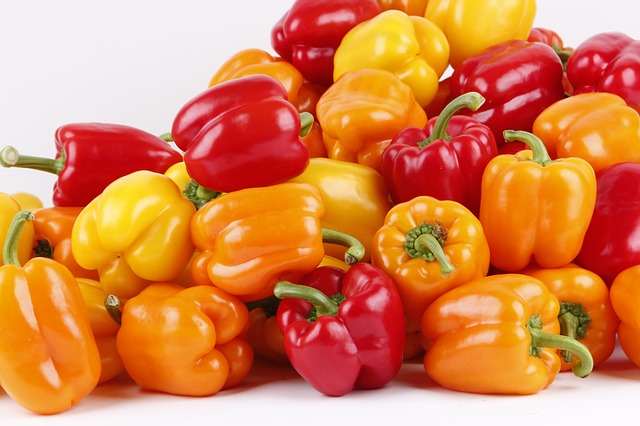Bell Peppers or Capsicum or Sweet Peppers are a widely popular vegetable because of it’s sweet, spicy or hot taste and also because of their varied colors. These are a rich source of Vitamin C. Bell peppers needs your little extra effort to grow. Keeping the plant moist and warm but at the same time protected from scorching heat & strong winds, needs a little care but not hard enough as long as you are aware of what is required by a pepper plant. Let’s discuss how to care for bell peppers plants.

Bell Peppers
Find the Ideal Place
- Peppers love sun. keep them at a spot which receive minimum 6 hours of sunlight.
- If you live in a warm/ desert like climate the try to place them at a spot where the plant can be protected from hot noon sun or try to put cluster of pots at one place.
- Plant peppers in fertile & well drained soil.
- If the soil is too clayey or sandy, add well matured organic compost before planting.
Watering
- Peppers require regular watering.
- Keep the soil moist. Peppers are very heat sensitive, don’t let the soil to dry out completely.
- Increase the water cycle if the climate is dry & warm.
- Don’t over water the plants as this will damage their roots.
- Water directly at the foot of the plant rather than sprinkling over the plant as wet foliage can attract fungal diseases.
Fertilizer
- Start fertilizing once the plant start setting fruit.
- Pepper plants are heavy feeders, so Fertilize them in every 15 – 2o days.
- If using chemical fertilizer, apply the one which has N-P-K ratio of 10:10:10 or 5:10:10.
- Before applying the fertilizer make sure the plant is watered well. Otherwise, the plant can take up too much fertilizer which will burn the plant.
- Spread the fertilizer on the soil leaving 4-5 inches from stem of the plant.
Mulching
- Cover the base of the plant with organic matter.
- Mulching helps the soil to remain cool & to retain moisture for somewhat longer than normal.
- If is important to leave a gap of 1-2 inches between the stem of the plant & mulch as this lower the possibility of any diseases.
Pruning & Pinching
- Once the plant become 10-12 inches tall, pinch the top growing tips to make it bushier.
- Normally pruning is not a necessity but can be done if required.
Pests and Diseases
- Normally the following pests found on pepper: Aphids, Spider Mites, Whiteflies etc.
- Spray the plant with insecticidal soap to remove pests.
- If the situation is more serious then apply pesticides.
Tips
- If required, support the plant with stakes.
- Harvest the fruit as soon as it reaches the desired size.
- For bigger fruit & more yield, spray the plant with a mixture of 1 tablespoon of Epsom salt in 4 liters of water every month.
- If the plant flowering too early, deadheads the flower. This will help the plant to grow more.
- If want to speed up the process of maturation of fruits, don’t let new fruits set in.
In Conclusion
Capsicum plants, also known as bell peppers or pepper plants, are a popular choice for gardeners and indoor plant enthusiasts alike. Proper capsicum plant care is essential for healthy growth and a bountiful harvest. If you’re growing your pepper plant indoors or in pots, make sure they receive plenty of sunlight and water regularly to keep the soil moist but not waterlogged. Overwintering pepper plants can be challenging, but you can try keeping them in a bright, cool area and reducing watering. For the best results, follow these pepper plant care instructions: fertilize regularly with a balanced fertilizer, prune to encourage bushy growth, and keep an eye out for pests and diseases. With the right care, you can enjoy growing capsicum in pots or in your garden, and enjoy fresh, delicious peppers all season long!
capsicum plant care, bell peppers plant care, pepper plant care, pepper plant care indoor, pepper plant care in pots, pepper plant care over winter, pepper plant care instructions, how to care for capsicum plant, how to care for bell peppers, how to care for bell pepper plants in pots, how to take care capsicum plants, growing capsicum in pots
